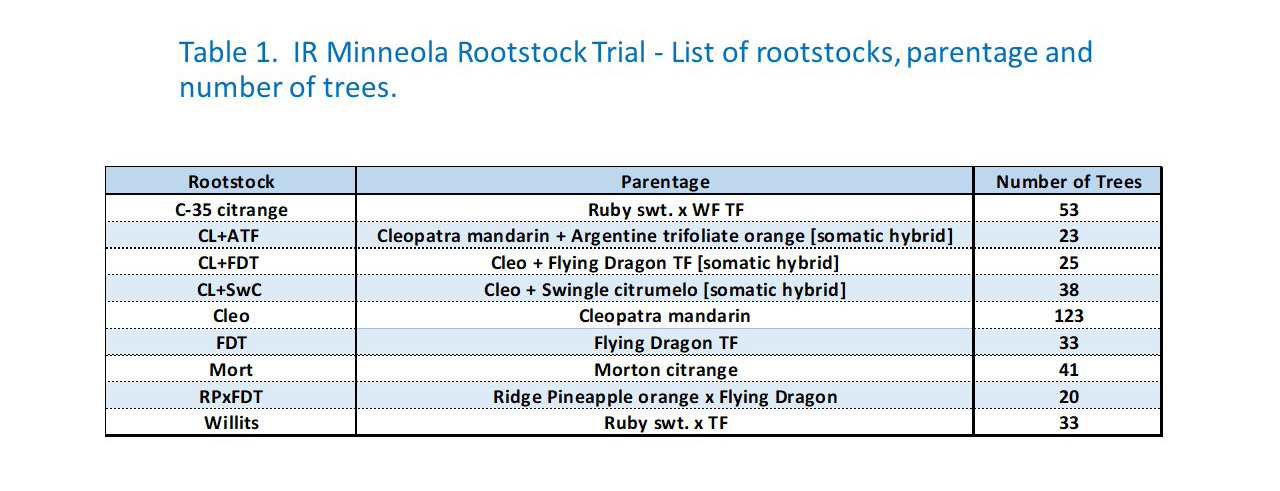Indian River [IR] Minneola Rootstock Trial, Vero Beach
Dr. Bill Castle – Dr. Fred Gmitter – Dr. Jude Grosser
July 13, 2021 - Updated
March 17, 2021 - Updated
November 05, 2020 - Updated
June 24, 2020 - Posted
CREC Citrus Plant Improvement
IR Minneola Rootstock Trial - Description
In this trial with Minneola tangelo scion, the main objectives were to control tree size by rootstock choice and determine if that increased fruiting without sacrificing fruit size, and to evaluate tree response to HLB. Evidence from other trials indicated such rootstocks as Flying Dragon trifoliate orange [FDT] had such effects; thus, FDT was included as the comparison standard for a group of somatic hybrids and other stocks that were promising for tree-size control in other trials.
This trial was planted in a commercial Minneola block with Temple as a pollinator. Among the Temple trees were 50 trees of a selection known as Fertic discovered as backyard trees in a Kissimmee homestead. Molecular analysis indicated the trees matched those of true Temple, however, the Fertic trees while growing in a St. Cloud cooperative project displayed no scab on the fruit or tree. Also, planted adjacent to the main trial were Minneola trees on C-35 citrange, Cleopatra mandarin and Morton citrange in sets of three, i.e., groups of one tree on each rootstock.
IR Minneola Rootstock Trial - Summary
- Location: Vero Beach, Indian River County
- Scions: Minneola
- Rootstocks: see Table 1.
- Date planted: May 2000
- Design: Randomized complete-block; 2 or mostly 3 replications
- Plot size: 10-12 trees
- Spacing: 10 x 25 ft. or 174 trees/acre
- Data:
- 2017/18: HLB rating; juice quality*.
- 2018/19: HLB rating; juice quality*; yield, PS/acre.
- 2019/20: HLB rating, juice quality*.
- 2020/21: HLB rating, % survival, yield, tree height.
- (*) No fruit was available for Willits rootstock at the time of sampling
- Trial status: INACTIVE

IR Minneola Rootstock Trial - Interpretive Summary [as of July 2021]:
This small trial was planted in 2000 mainly for observational purposes to see how somatic hybrids, a new type of rootstock, would perform especially with regard to reducing tree size. The trial was designed with replicates to allow statistically valid data to be collected as possible. The trial was inactivated in 2021.
Tree survival [Fig. 22]. Most of the original tees survived except for those on CL+ATF [60%] and RPxFDT [70%].
Tree ht. [Fig. 23]. At age 11 years, tree height ranged from 12 ft. [e.g., RPxFDT and FDT] to 9 ft. [C-35 and CL+FDT].
HLB. Ratings were made in four seasons with visible symptoms apparent, but with no overall strong effects or clear distinctions among rootstocks. In most seasons, the most obvious effect was fruit drop, again with no differences among rootstocks.
Yield [Fig. 25]. In the two years yield was measured, data were obtained for both years from 6 of 9 rootstocks. Most trees were similar in tree height and yield to those on Cleopatra mandarin.
Juice Brix. Over three seasons with fruit samples collected in January, Brix values were mostly in the range of 10.5 to 13. In two seasons, the higher values were from trees on FDT and CL+FDT rootstocks. However, bear in mind that the presence of HLB among the trial trees may have influenced the data. No separation of fruit into that with or without HLB symptoms was attempted during sampling.
Rootstocks. For those trees on rootstocks with 90-100% survival, no dramatic reduction [>30%] in tree height was achieved nor any substantial improvement in juice quality or tolerance to HLB. Minneola was compatible with all the somatic hybrid rootstocks and Flying Dragon trifoliate orange.

.jpg)